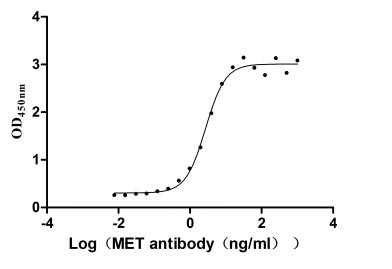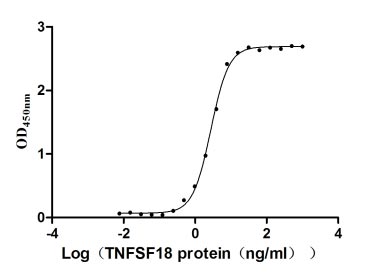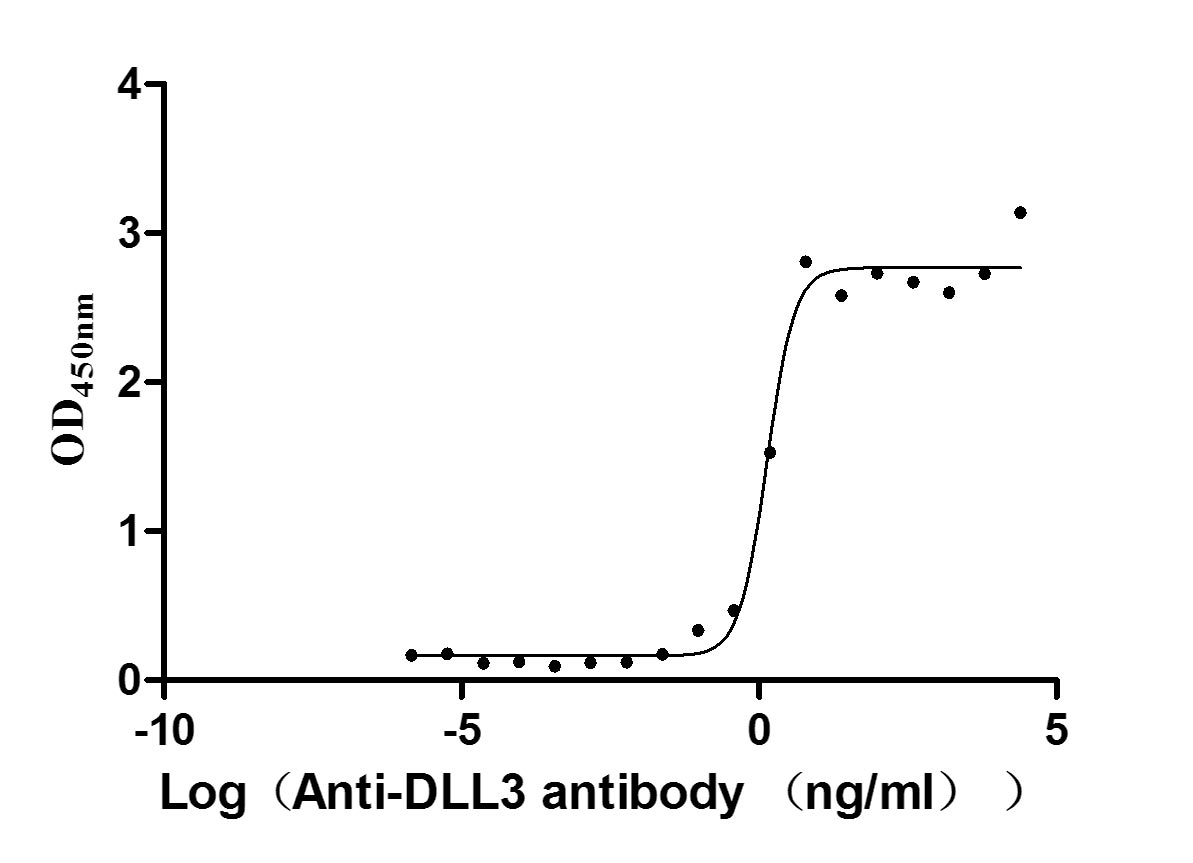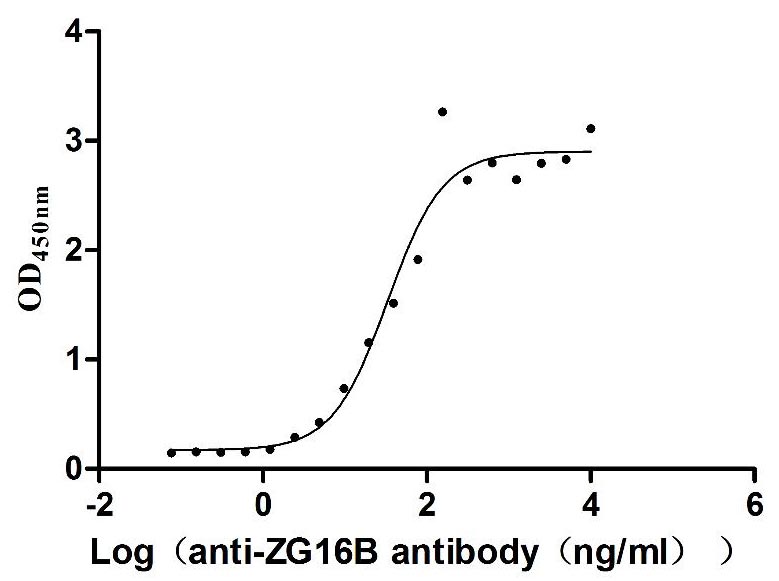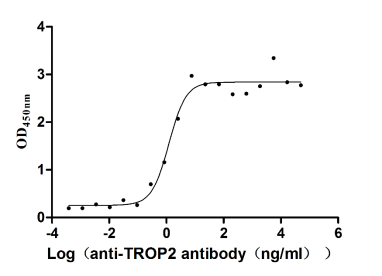Recombinant Human Leucine-rich repeat-containing G-protein coupled receptor 4 (LGR4), partial
-
中文名称:人LGR4重组蛋白
-
货号:CSB-YP883618HU
-
规格:
-
来源:Yeast
-
其他:
-
中文名称:人LGR4重组蛋白
-
货号:CSB-EP883618HU
-
规格:
-
来源:E.coli
-
其他:
-
中文名称:人LGR4重组蛋白
-
货号:CSB-EP883618HU-B
-
规格:
-
来源:E.coli
-
共轭:Avi-tag Biotinylated
E. coli biotin ligase (BirA) is highly specific in covalently attaching biotin to the 15 amino acid AviTag peptide. This recombinant protein was biotinylated in vivo by AviTag-BirA technology, which method is BriA catalyzes amide linkage between the biotin and the specific lysine of the AviTag.
-
其他:
-
中文名称:人LGR4重组蛋白
-
货号:CSB-MP883618HU
-
规格:
-
来源:Mammalian cell
-
其他:
产品详情
-
纯度:>85% (SDS-PAGE)
-
基因名:
-
Uniprot No.:
-
别名:BNMD17; G protein coupled receptor 48; G-protein coupled receptor 48; GPR48; Leucine-rich repeat-containing G protein-coupled receptor 4; Leucine-rich repeat-containing G-protein coupled receptor 4; LGR4; LGR4_HUMAN
-
种属:Homo sapiens (Human)
-
蛋白长度:Partial
-
蛋白标签:Tag type will be determined during the manufacturing process.
The tag type will be determined during production process. If you have specified tag type, please tell us and we will develop the specified tag preferentially. -
产品提供形式:Lyophilized powder
Note: We will preferentially ship the format that we have in stock, however, if you have any special requirement for the format, please remark your requirement when placing the order, we will prepare according to your demand. -
复溶:We recommend that this vial be briefly centrifuged prior to opening to bring the contents to the bottom. Please reconstitute protein in deionized sterile water to a concentration of 0.1-1.0 mg/mL.We recommend to add 5-50% of glycerol (final concentration) and aliquot for long-term storage at -20℃/-80℃. Our default final concentration of glycerol is 50%. Customers could use it as reference.
-
储存条件:Store at -20°C/-80°C upon receipt, aliquoting is necessary for mutiple use. Avoid repeated freeze-thaw cycles.
-
保质期:The shelf life is related to many factors, storage state, buffer ingredients, storage temperature and the stability of the protein itself.
Generally, the shelf life of liquid form is 6 months at -20°C/-80°C. The shelf life of lyophilized form is 12 months at -20°C/-80°C. -
货期:Delivery time may differ from different purchasing way or location, please kindly consult your local distributors for specific delivery time.Note: All of our proteins are default shipped with normal blue ice packs, if you request to ship with dry ice, please communicate with us in advance and extra fees will be charged.
-
注意事项:Repeated freezing and thawing is not recommended. Store working aliquots at 4°C for up to one week.
-
Datasheet :Please contact us to get it.
相关产品
靶点详情
-
功能:Receptor for R-spondins that potentiates the canonical Wnt signaling pathway and is involved in the formation of various organs. Upon binding to R-spondins (RSPO1, RSPO2, RSPO3 or RSPO4), associates with phosphorylated LRP6 and frizzled receptors that are activated by extracellular Wnt receptors, triggering the canonical Wnt signaling pathway to increase expression of target genes. In contrast to classical G-protein coupled receptors, does not activate heterotrimeric G-proteins to transduce the signal. Its function as activator of the Wnt signal...显示更多
-
基因功能参考文献:
- Loss of LGR4 abrogated RSPO3-regulated osteogenesis and RSPO3-induced ERK1/2 signalling inhibition. PMID: 28220828
- Luciferase reporter assay was performed to confirm that LGR4 is a direct target gene of miR-137 with a potential binding site in the 3'UTR of LGR4. PMID: 29786747
- the host protein leucine-rich repeat-containing G protein-coupled receptor 4 (Lgr4) is essential for VSV and VSV-G pseudotyped lentivirus (VSVG-LV) to infect susceptible cells. PMID: 28842478
- High LGR4 expression is associated with osteoarthritis. PMID: 28777797
- Data (including data from studies using transgenic/knockout mice) suggest that LGR4 is key protein necessary for prostate cancer epithelial-mesenchymal transition and metastasis; LGR4 expression is elevated in human prostate cancer cell lines with metastatic potential; LGR4 silencing in prostate cancer cell line impairs cell migration and invasion without affecting cell proliferation. PMID: 28768769
- LGR4 is another receptor for RANKL. LGR4 competes with RANK to bind RANKL and suppresses canonical RANK signaling during osteoclast differentiation. PMID: 27064449
- The LGR4 A750T variant is correlated with central obesity-related characteristics in young subjects. PMID: 27925416
- Lgr4 is a critical positive factor for skin tumorigenesis by mediating the activation of MEK1/ERK1/2 and Wnt/beta-catenin pathways. PMID: 27693558
- miR-34a gene expression upregulation inhibits ARPE-19 cell proliferation, migration and adhesion partly by suppressing LGR4 expression. PMID: 27977785
- Lgr4 activates Jmjd2a/AR signaling pathway to promote interaction AR with PSA promoter, causing reduction of prostate cancer apoptosis and cell cycle arrest. PMID: 27743893
- A mechanistic understanding of RANKL-LGR4 interaction has provided new insight into LGR4 mediated RANKL signaling in osteoporosis and other diseases PMID: 27178473
- miR-218 directly targets LGR4 and modulated the PI3K/Akt and Wnt/beta-catenin pathways in the LNCaP-IL-6+ cells. PMID: 26986507
- LGR4 promotes tumorigenesis of prostate cancer via PI3K/Akt signaling pathway. PMID: 25636507
- These findings suggest that aberrant RSPO3-LGR4 signaling potentially acts as a driving mechanism in the aggressiveness of Keap1-deficient lung ADs. PMID: 25531322
- the LGR4-Rspo1 complex crystal structure shows divergent mechanisms of ligand recognition by leucine-rich repeat G-protein-coupled receptors PMID: 25480784
- our results suggest a previously unknown Stat3-LGR4 molecular network, which may control osteosarcoma development and progression PMID: 24455684
- RSPO-LGR4 not only induces the clearance of RNF43/ZNRF3 to increase Wnt receptor levels but also recruits IQGAP1 into the Wnt signaling complex. PMID: 24639526
- Lgr4, which regulates eye, kidney, testis, ovary, and uterine organ development as well as mental development through genetic and epigenetic surveillance, is a novel candidate gene for the pathogenesis of AGR syndrome PMID: 24519938
- GPR48 overexpression promotes cancer cell proliferation via activation of Wnt signaling. PMID: 24083742
- Lgr4 overexpression promoted glioma cell proliferation through activation of Wnt signaling. PMID: 24083766
- Upregulation of GPR48 resulted in increased phosphorylation of glycogen synthase kinase 3beta. PMID: 23803691
- A functional low-frequency human LGR4 variant (A750T) has been associated with body mass index in a Chinese obese-versus-control study. PMID: 24212090
- Multi-functional norrin is a ligand for the LGR4 receptor. PMID: 23444378
- the c.376C>T mutation is associated with low BMD and osteoporotic fractures, electrolyte imbalance, late onset of menarche, reduced testosterone levels, and an increased risk of squamous cell carcinoma of the skin and biliary tract cancer PMID: 23644456
- Lgr4/Gpr48 plays a critical role in modulating the TLR2/4 signaling pathway and represents a useful therapeutic approach of targeting Lgr4/Gpr48 in TLR2/4-associated septic shock and autoimmune diseases. PMID: 23589304
- R-Spondin potentiates Wnt/beta-catenin signaling through orphan receptors LGR4 and LGR5 PMID: 22815884
- LGR4 and LGR5 bind the R-spondins with high affinity and mediate the potentiation of Wnt/beta-catenin signaling by enhancing Wnt-induced LRP6 phosphorylation. PMID: 21693646
- GPR48 may play an important role in invasiveness and metastasis of carcinoma and might represent a potential prognostic marker or therapeutic target. PMID: 17178856
- Testicular efferent ducts in the mutant mouse are dramatically shortened and less convoluted than in the wild-type animal, providing an explanation to the phenotype observed in LGR4KO. PMID: 19301269
- Data show that GPR48 shRNA can inhibit in vitro invasion and in vivo metastasis of HeLa cells efficiently. PMID: 19550120
收起更多
-
相关疾病:Osteoporosis (OSTEOP)
-
亚细胞定位:Cell membrane; Multi-pass membrane protein.
-
蛋白家族:G-protein coupled receptor 1 family
-
组织特异性:Expressed in multiple steroidogenic tissues: placenta, ovary, testis and adrenal. Expressed also in spinal cord, thyroid, stomach, trachea, heart, pancreas, kidney, prostate and spleen.
-
数据库链接:


